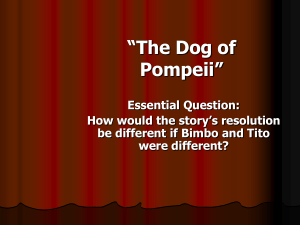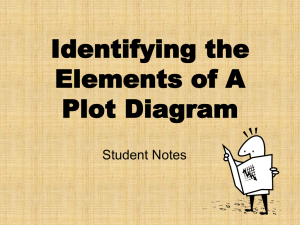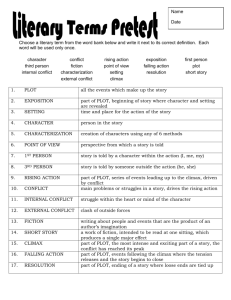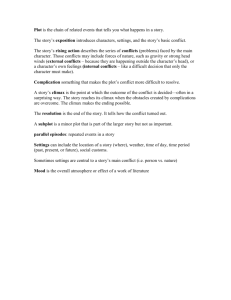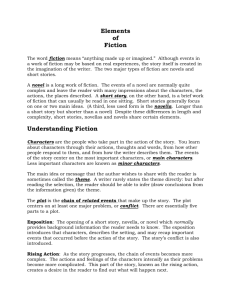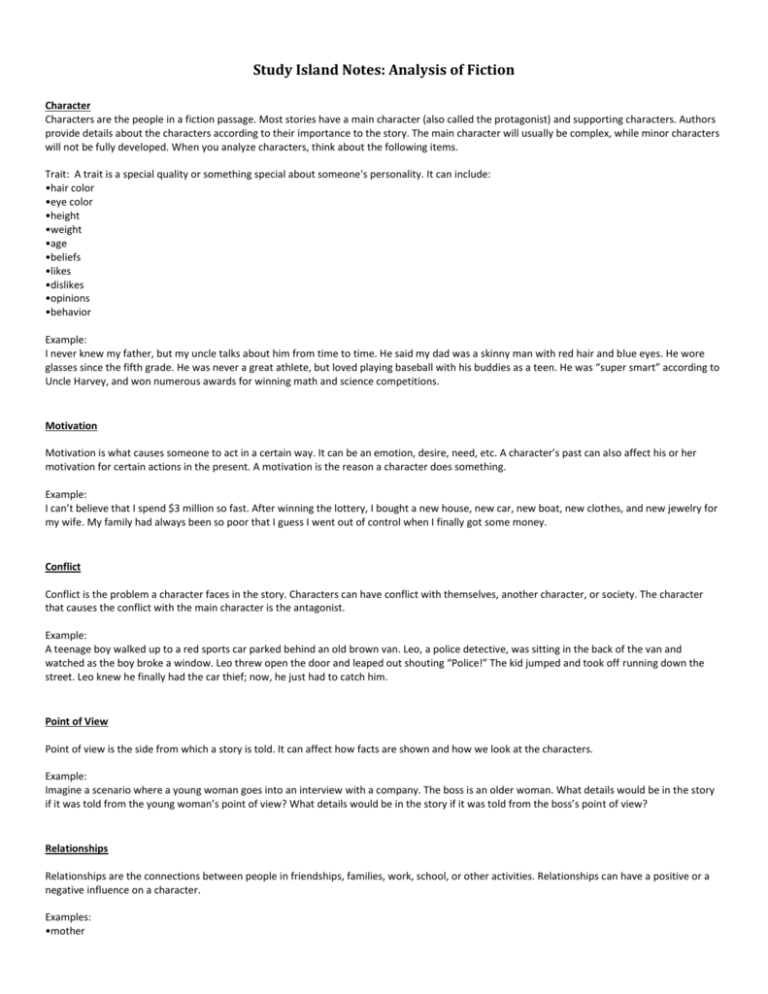
Study Island Notes: Analysis of Fiction
Character
Characters are the people in a fiction passage. Most stories have a main character (also called the protagonist) and supporting characters. Authors
provide details about the characters according to their importance to the story. The main character will usually be complex, while minor characters
will not be fully developed. When you analyze characters, think about the following items.
Trait: A trait is a special quality or something special about someone's personality. It can include:
•hair color
•eye color
•height
•weight
•age
•beliefs
•likes
•dislikes
•opinions
•behavior
Example:
I never knew my father, but my uncle talks about him from time to time. He said my dad was a skinny man with red hair and blue eyes. He wore
glasses since the fifth grade. He was never a great athlete, but loved playing baseball with his buddies as a teen. He was “super smart” according to
Uncle Harvey, and won numerous awards for winning math and science competitions.
Motivation
Motivation is what causes someone to act in a certain way. It can be an emotion, desire, need, etc. A character’s past can also affect his or her
motivation for certain actions in the present. A motivation is the reason a character does something.
Example:
I can’t believe that I spend $3 million so fast. After winning the lottery, I bought a new house, new car, new boat, new clothes, and new jewelry for
my wife. My family had always been so poor that I guess I went out of control when I finally got some money.
Conflict
Conflict is the problem a character faces in the story. Characters can have conflict with themselves, another character, or society. The character
that causes the conflict with the main character is the antagonist.
Example:
A teenage boy walked up to a red sports car parked behind an old brown van. Leo, a police detective, was sitting in the back of the van and
watched as the boy broke a window. Leo threw open the door and leaped out shouting “Police!” The kid jumped and took off running down the
street. Leo knew he finally had the car thief; now, he just had to catch him.
Point of View
Point of view is the side from which a story is told. It can affect how facts are shown and how we look at the characters.
Example:
Imagine a scenario where a young woman goes into an interview with a company. The boss is an older woman. What details would be in the story
if it was told from the young woman’s point of view? What details would be in the story if it was told from the boss’s point of view?
Relationships
Relationships are the connections between people in friendships, families, work, school, or other activities. Relationships can have a positive or a
negative influence on a character.
Examples:
•mother
•sister
•friend
•teacher
•neighbor
•father
•boss
Think about how all these character traits affect the story. A character's traits or relationships might affect his or her point of view. Motivation
affects action and changes. When we understand all of these things, a character becomes easy to understand. When writing your own characters,
think about all these things. You'll be on your way to making an interesting and deep character.
Plot
Plot is the storyline or sequence of events that take place in a story. It is what happens in a story. All fictional stories have a plot, and all plots have
a conflict and a resolution. Conflict is the opposition between characters or forces that shapes or motivates the action of the plot. The resolution is
how the conflict is solved and brought to an end.
The plots of most stories have five common parts: the exposition, the rising action, the climax, the falling action, and the resolution.
1.
Exposition—This is the beginning of the plot. It starts off the story and lets the reader know any important information before the action
starts. It introduces the characters, the setting, and the basic conflict of a story. A conflict is a problem or obstacle that the characters
must overcome.
2.
Rising action—This occurs after the main conflict is introduced. It includes details about what the character does to solve his or her
problem. Smaller problems, obstacles, or crises may occur before the climax is reached.
3.
Climax—This occurs right after the rising action. It is the most intense or exciting event in the story because the character deals with the
main conflict for the last time. It is also the turning point in the story. After the climax, things either get better or worse for the character.
4.
Falling action—This occurs after the climax and before the resolution. It is everything that happens because of the climax. The characters
respond to what happens in the climax. This leads the reader to the conclusion of the story.
5.
Resolution—This is the conclusion of the story. It ties together the whole story. It explains how the conflict is resolved and what happens
to the characters after the story ends.
Setting
Setting is the time, place, and circumstances in which a story takes place. It tells the reader where and when the story occurs.
The main components of setting include:
•place (geographical location)
•time
•weather
•social conditions
•mood (atmosphere)
Things to remember when analyzing setting:
The setting in a story is not always directly stated. Sometimes you have to use clues to recognize the setting. Below are some examples of
sentences that would give the reader clues about the setting.
•"It’s our last night of vacation, and we already have tickets to see a Broadway play."
•"The cold wind whipped through the bare trees and rolled over the mounds of snow."
•"I wanted to get home quickly so that I wouldn’t miss a minute of President Roosevelt’s radio address."
Authors take great care when choosing the settings for their stories. The setting can have an effect on the reader by mirroring the mood or theme.
•Stories about renewal will often take place in the spring.
•When a character is sad or depressed, the weather is often gloomy, cloudy, or rainy.
•Suspenseful or scary stories usually take place at night.
In some stories, the setting can have an effect on the characters or conflict.
•The setting is part of the conflict when a character becomes lost in a forest and faces environmental challenges.
•The setting affects characters when the weather changes or ruins a character’s plans.
•Characters will act in different ways depending on the time period in which a story takes place. How would a woman in a Civil War story act
differently from a woman in a modern story?
Copyright © 2013 Study Island - All rights reserved.


